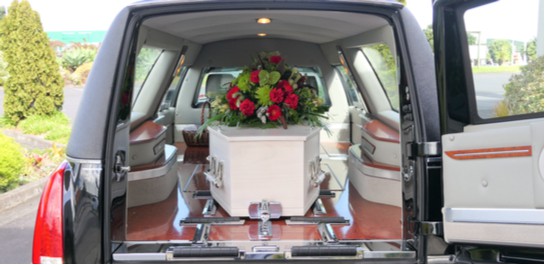Today, it is important to understand the etiquette associated with motorized funeral processions to ensure you do not disrespect the deceased.
Proper etiquette includes being respectful, yielding to the procession, and ensuring that you don’t cut through or in front of the procession.
The following post describes standard funeral procession procedures, details the proper etiquette to use when driving in or encountering funeral processions, and examines how the highway laws for funeral processions vary from state to state.
Etiquette When Encountering a Funeral Procession
There are no federal laws that dictate what you should do when you encounter a funeral procession. Therefore, most of the etiquette rules surrounding funeral processions are based on tradition and respect.
When in doubt about what to do in the presence of a funeral procession, remember the two golden rules:
- Treat the procession how you would want your loved one’s procession to be treated.
- Treat the procession the same way you would treat an emergency vehicle.
More specifically, it is best to practice the following etiquette when you are driving near a funeral procession.
- Be respectful.
Do not honk your horn, rev your engine, or do anything that would be construed as disrespectful to the deceased.
- Yield to the funeral procession.
Though many states do not legally require you to yield, yielding to a funeral procession is the societal norm.
If in a position to do so, it is also common to pull over and allow the funeral procession to pass you. However, do not pull over unless you are in a position where you can safely do so.
- Don’t Pass on the Right.
Funeral processions drive slowly. It can therefore be tempting to pass the procession, especially on the highway. While passing in the left lane (fast lane) is acceptable, it is considered rude to pass on the right.
- Wait for the Last Vehicle.
The last vehicle in a funeral procession is typically denoted with flags and hazard lights. Once the final vehicle of the procession passes you, you can return to normal traffic flow.
- Don’t Join or Cut Through a Procession.
A funeral procession allows friends and family to travel in solidarity with the deceased as they make the journey to their final resting place. It is therefore important that the funeral procession is allowed to stay together.
Make sure you do not cut through a funeral procession or join a funeral procession, even if there is space to do so.
Though funeral processions can cause traffic delays and hinder the transportation of others, it is important to remember that, for those involved, the funeral procession represents a solemn and important journey. Be respectful, be courteous, and be supportive of their grieving process.
Etiquette When Driving in a Funeral Procession

Funeral processions are still common for funerals at which the funeral location is different than the burial location. It is therefore likely that you will be part of a funeral procession at some point in your life. When that moment arrives, it is important to understand the etiquette that is expected.
When driving in a funeral procession, remember the following:
- Arrive Early.
As seen below, the funeral procession is typically led by the family and close friends, followed by any other attendees. If you are a family member or close friend of the deceased and driving your own car, it is important to ensure you get to the funeral location early.
A good rule of thumb is to arrive 45 minutes early to ensure that you are parked near the front of the procession.
- Drive Slowly.
Funeral processions typically go 20 miles per hour (mph) on residential streets and no more than 55 mph on highways. The slow speed of the funeral procession serves three purposes:
- To minimize the chance of accidents or incidents, since vehicles typically drive closer together and ignore standard traffic laws.
- To prevent other drivers from separating the funeral procession by joining or cutting off a section of the funeral procession.
- To emulate the slow somber march of the historical walking funeral processions.
- Pay Close Attention to the Rules.
During the funeral or immediately following the funeral, the Funeral Director or funeral attendants will give you directions and explain any special traffic laws that may apply.
For example, in certain states, you have the right-of-way at red lights and stop signs.
Even if you are a seasoned driver, it is very important to listen to the rules so that you don’t cause any disruptions during the procession.
- Turn on Your Headlights and Use Your Flags.
For safety reasons, it is important to clearly show other drivers that you are in a funeral procession. In the United States, all vehicles in a funeral procession are expected to drive with their lights or hazard signals on.
Many funeral homes also give the vehicles in a funeral procession magnetic flags marked “Funeral” or “F” to help distinguish the procession for other vehicles.
If you are given a flag for your car, you should put in on the left side of the roof, right above the driver’s seat.
- Check the Route.
Despite the best laid plans, you may get separated from the funeral processions on the journey. It is therefore important that you know the route and follow it if you are separated from the lead cars.
- Stay Together At All Times. .
When driving, try to keep your car within 1-2 car lengths of the vehicle in front of you. This ensures that no outside drivers enter the procession or cut you off
If you are located in a state where you have the right-of-way, make sure you stay with the vehicle in front of you, even if it requires you to ignore normal traffic laws. In these instances, the only time you should stop following the vehicle in front of you is when an emergency vehicle is approaching.
- Pay Attention to Parking.
This rule applies to both the start and end of the procession. When you arrive at the funeral location, parking attendants will likely instruct you to park your car in the funeral procession line so that you can easily begin the procession following the funeral.
If parking attendants are not present, make sure you park backed in, and in a location where you can easily join the procession following the service.
Once you arrive at the cemetery, follow the funeral attendant instructions for parking. In most cases, the funeral procession will break away from the hearse, which will travel much closer to the burial location. It is therefore best to research the cemetery parking ahead of time so that, if no attendants are present, you know where to park your vehicle.
Overall, as a driver in a funeral procession, your job is to drive safely, and to respect both the deceased and the other drivers around you.
If you have any questions or concerns on the day of the funeral procession, it is always best to ask the Funeral Director or funeral attendants before the procession begins.
Order of Events for a Funeral with a Funeral Procession

When participating in a funeral procession, it is important to understand the order in which things will happen so that you are on time and prepared.
During a typical funeral with a funeral procession, you will go through the following steps:
- When you arrive at the funeral location, funeral attendants will show you where to park your car based on where you will be located within the funeral procession. If you are a close friend or family member, you should plan on arriving early to secure a spot at the front of the procession.
- The funeral itself will likely include a small funeral procession and recession. During the funeral recession, pallbearers will carry the casket out of the church or funeral home and into the waiting hearse. The pallbearers will be followed by the immediate family, followed by the funeral attendees. At this time, you will walk to your car and wait for the funeral procession to the cemetery to begin.
- The funeral procession will travel from the funeral location to the cemetery.
- A small internment ceremony will typically be held during the burial.
Order of Vehicles in a Funeral Procession
The modern funeral procession emulates the historical funeral processions, in which family members carried the deceased from their home to the cemetery. As such, it is important to adhere to the hierarchy that is established for the procession.
Vehicles in a funeral procession are lined up in a specific order to ensure that the immediate family is closest to the deceased, while the casual friends and acquaintances are farther away. In general, funeral processions are set up in the following order:
- Police Escort. When required, the funeral procession is led by a police escort.
- Lead Car. The lead car is driven by the Funeral Director or an employee of the funeral home. It is responsible for leading the procession and ensuring that the procession follows the appropriate traffic laws. It is typically a black sedan bearing white flags to signify the start of the funeral procession.
- Hearse. The hearse, also called the funeral coach, is driven by an employee of the funeral home or cemetery. The hearse carries the deceased in the casket.
- Immediate Family Vehicle(s). The immediate family, including parents, kids, and spouses, follow the hearse in a chauffeured vehicle. The immediate family’s vehicle is typically a black limousine, sedan, or van.
- Vehicles of Family and Close Friends. The immediate family of the deceased typically let people know if they should be at the front of the procession. Therefore, if you have not talked to the family, it is usually best to hang back.
- All Additional Funeral Attendees. Anyone else who attended the funeral fills in at the end of the procession.
Funeral Procession Laws by State

There are no federal laws for funeral processions. However, many states and counties have laws that dictate traffic protocol for both the funeral procession and drivers around it. Before having a funeral procession, it is important to research your state and county laws to ensure that you follow all applicable rules and guidelines.
A few state laws worth noting include:
- Nevada and Kentucky are the only states that allow the lead vehicle in a funeral procession to proceed through red lights and stop signs without stopping.
- Arizona, Idaho, Kentucky, Montana, North Carolina, and North Dakota give drivers in funeral processions the right-of-way in nearly all driving scenarios.
- Florida, Illinois, Louisiana, Maryland, Missouri, New Hampshire, Oregon, Pennsylvania, Rhode Island, Tennessee, West Virginia, Wisconsin, and Wyoming give funeral processions the right-of-way and dictate that if the lead car enters the intersection legally, all other cars may follow, regardless of traffic signals.
- Georgia, Michigan, Minnesota, and Ohio give right-of-way to funeral processions at intersections.
- Virginia gives right-of-way to a funeral procession only if it is escorted by a police or Sherriff’s escort.
A full list of funeral procession laws by state can be found at Funeral Procession Traffic Laws in All 50 States.

Sources:
https://www.mwl-law.com/wp-content/uploads/2018/02/FUNERAL-PROCESSION-TRAFFIC-LAWS.pdf
https://everloved.com/articles/funeral-etiquette/funeral-procession-etiquette/

